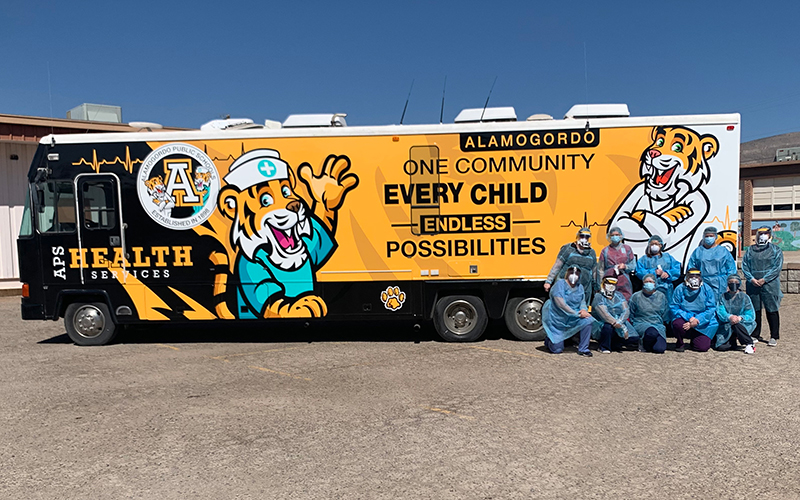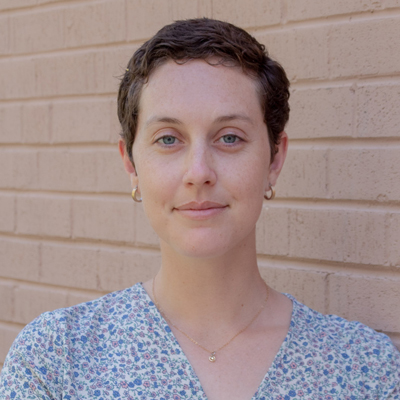
The Alamogordo Public Schools health services team gets ready to hand out snacks and water bottles with barcodes linking to mental health resources. This RV, called Flo, was purchased with CARES Act money as a way for district nurses to stay connected with students during the COVID-19 pandemic. (Photo courtesy of Lisa Patch/Alamogordo Public Schools)

A few times a month, this 40-foot RV pulls up to Washington Park in Alamogordo, New Mexico, and nurses distribute crayons and coloring books, pamphlets on health care and water bottles with barcodes linking to resources for mental health. (Photo courtesy of Lisa Patch/Alamogordo Public Schools)

Michelle Graves poses with her son, Isaiah, and daughters Isabella, in the red dress, and Idalis. Isabella has a brain malformation that requires her to check in daily with school nurses. “The school nurses have brought a lot of comfort and ability for me to have some kind of ‘normalcy’ in my daily activity,” Graves says. (Photo courtesy of Michelle Graves)
PHOENIX – A few times a month, a 40-foot motor home – its exterior adorned with cartoon tigers dressed as medical workers – pulls up to Washington Park in Alamogordo, New Mexico. As children gather round, nurses distribute crayons and coloring books, pamphlets on health care and water bottles with barcodes linking to resources for mental health.
This RV-turned-nurse’s office was purchased and fixed up last July with about $26,000 in federal CARES Act money as a way for one school district to stay connected with students and keep providing some modicum of care during the COVID-19 pandemic.
“We call her Flo, for Florence Nightingale, because we just got tired of saying the motor home,” said Lisa Patch, director of health services for Alamogordo Public Schools. “It seemed to fit, so she’s taken on her own persona.”
For many families across the U.S., and especially in underserved communities, school nurses are often the first line of defense for children’s health care. But when schools transitioned to remote learning during COVID-19, nurses had to adapt to meet the needs of their students.
Now, as schools prepare to return to in-person learning this fall, nurses are bracing for the unexpected amid varying requirements for vaccinations and masks and efforts to get back to “normal” after a year like no other.
“When COVID came along,” Patch said, “we had to become expert contact tracers and know all things about COVID and COVID testing and the different COVID vaccines and where you can get them.
“That’s what I appreciate so much about the team that I work with. From the very beginning, they were like, ‘We’re not going to sit at home and be virtual school nurses. We’ve got to be out there. How can we help our community?’”
Patch and her team started lockdown similar to many, making sure the 6,000 students within the southern New Mexico district had the resources they needed for remote learning.

Lisa Patch, director of health services for Alamogordo Public Schools, talks with children during a safety class on extreme heat. Nurses in this New Mexico school district bought and fixed up an RV to hit the road to help students during COVID-19. (Photo courtesy of Lisa Patch/Alamogordo Public Schools)
Another priority was easing anxiety and maintaining a sense of community, so health services team members made a video of various activities they were pursuing amid stay-at-home orders and shared it with students, along with another video with ideas for what the kids might do once homework was done.
The team also created virtual health offices that were available during online classes. Students could enter online rooms and click on different posters on virtual walls to learn more about such topics as mental health and COVID-19.
Then last July, Patch received an email about a recreational vehicle the Lions Club was selling. The timing was perfect, with the team brainstorming ways to reintroduce safe, in-person interaction.
The nurses cleaned out the RV while custodial staff repainted the inside and the school mechanic worked on the engine. Once all of that was done, the exterior of the vehicle was wrapped with images of the school mascot – a tiger – in medical gear.
By November, Flo was on the road. The nursing team launched drive-thru health fairs to provide COVID-19 tests, school supplies and food, held events to offer tips on dealing with extreme summer heat, and began stopping at the local park to hand out water bottles and connect.
The school district plans to continue using Flo throughout the summer and into the fall. Nurses plan to use it for telehealth appointments and are awaiting licensing to administer vaccines to children from the RV.

Michelle Graves of Tularosa, New Mexico, depends on school nurses to help watch over her 16-year-old daughter, Isabella, who is seen here with school nurse Joanne Gronewold. Isabella has a brain malformation that can cause seizures and other problems. (Photo courtesy of Michelle Graves)
“Right now, our goal is getting as many children 12 and older vaccinated as we can before school starts, so we’re sending out flyers,” Patch said. “We will be going out to the different free lunch programs and offering vaccinations.”
The role of school nurses has evolved and expanded over the years. They deal not just with minor problems but help monitor children with chronic illnesses, ensure medication gets taken on time, connect underserved and uninsured families to health care, and watch for the first signs of mental health struggles or other serious health issues.
“School nurses, because they work directly in communities where families live, learn, work, play, are the health care provider that many children see most frequently … some of them every day for maintenance of a chronic health condition,” said Laurie Combe, president of the National Association of School Nurses. “And for other students who are not insured, families are relying on that school nurse to be their health care provider.”
In some ways, the Alamogordo district is an outlier, with a nurse permanently assigned to most of its 15 schools. Exceptions are a rural school with just 30 students, where a nurse visits once a week, and two campuses on an Air Force base that share a registered nurse, according to Patch.
In contrast, the nation as a whole is grappling with a shortage of school nurses. About 40% of schools across the U.S. employ a full-time nurse, while 35% have part-time nurses and about a quarter have no nurse at all, according to Combe’s group.
The American Academy of Pediatrics recommends that each school have at least one full-time nurse, but there is no federal requirement that districts employ nurses. Many states, including Arizona, also do not require school nurses. New Mexico also has no such mandate, despite legislative attempts in past years.
A proposal to help K-12 schools hire more nurses has been introduced in Congress multiple times, but it has gone nowhere. In May, Rep. Dina Titus, D-Nev., and Sen. Jon Tester, D-Mont., reintroduced the legislation, which would provide grant money from the U.S. Department of Education to help pay for nurses.
“As students return to the classroom,” Titus said, “school nurses will play a key role in stopping the spread of COVID-19. These health care heroes administer COVID-19 tests, monitor students for symptoms, and can assist with vaccinations.”
Titus noted that the school district in Clark County, Nevada, which includes Las Vegas, has just 196 full-time nurses serving more than 350 schools.
“School nurses have always been vital to creating a healthy learning environment for students, and that is true now more than ever,” she said.
As part of the COVID-19 stimulus package President Joe Biden signed in March, the administration is directing at least $500 million to support the hiring of more school nurses. Additional funding is being allotted to state education agencies to help schools reopen – including hiring more nurses. Arizona is allocated more than $2 billion in funding, while New Mexico received about $980 million.
Michelle Graves is a parent of a child with a chronic illness in the Alamogordo school district. Her 16-year-old daughter, Isabella, has a brain malformation called periventricular nodular heterotopia. She has an intellectual disability, is considered legally blind, uses a feeding tube and is at risk for choking and seizures.
Before the pandemic, when Isabella attended school in person, she visited the nurse’s office at least twice a day for checkups, and any time she ate, a staff member was present to ensure she didn’t choke. Throughout the day, the school nurse would send text updates to Graves.
“The school nurses have brought a lot of comfort and ability for me to have some kind of ‘normalcy’ in my daily activity and daily routines because I know: One, they’re trained. Two, they’re knowledgeable. Three, I’ve always had great communication with any nurse that has worked with Isabella,” Graves said.
Once the lockdown hit and Isabella was home all day, Graves, director of nursing and family health at Alamogordo Family Health Center, had to coordinate care with various family members to allow her to go into work. But the school nurses would still check in virtually.
“Some of the nurses would ask if it was OK for them to join in on a Zoom so they could just see how she’s doing … just to be able to see her and let them know that, ‘Hey, we’re still here for you, Isabella, and we want you to see us.’”
Isabella returned to in-person school last spring. Though Graves remains concerned about COVID-19 and its potential effects on her daughter, given her condition, she believes the benefits of Isabella being back in the classroom outweigh the risks.
“I’m hoping that people are taking precautions – that if their child is sick, keep them home,” Graves said. “She loves going to school and socializing, but I do worry.”


